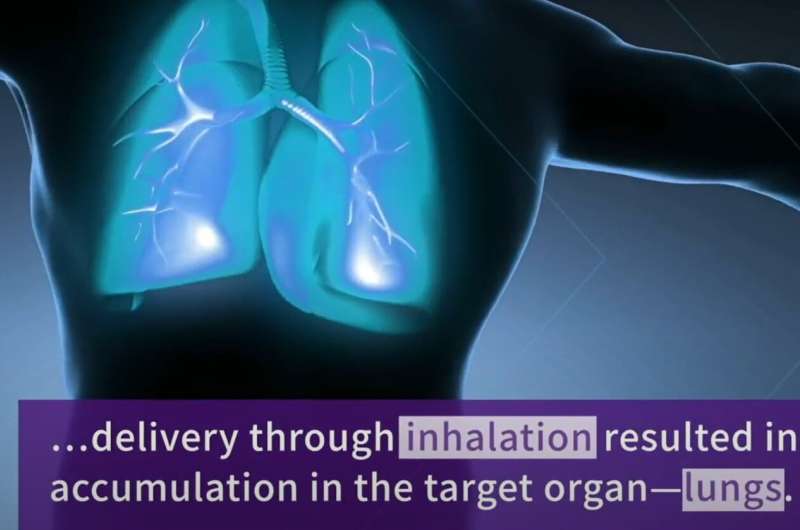Infection
Inhaled receptor decoy therapy confers protection against SARS-CoV-2 infection in preclinical models
The surface protein of the severe acute respiratory syndrome coronavirus 2 (SARS-CoV-2), known as the spike protein, is critical for infecting host cells. The spike protein facilitates the infection process by binding to angiotensin-converting enzyme 2 (ACE2) receptors on the surface of airway epithelial cells, initiating the virus entry into the cells.
By engineering an ACE2 receptor to increase the affinity to the spike protein, researchers demonstrated a novel method to neutralize the virus effectively. The engineered ACE2 (3N39v4-Fc) acts as a decoy by binding to the viral spike protein, thus preventing the binding of viruses to the ACE2 receptor on the cell surface. This inhibition by the ACE2 decoy is detrimental to SARS-CoV-2.
The study was carried out by a team of researchers led by Professor Toru Okamoto from the Department of Microbiology at Juntendo University. The team, including Prof. Okamoto, Dr. Atsushi Hoshino from the Department of Cardiovascular Medicine at Kyoto Prefectural University of Medicine, and Prof. Junichi Takagi from the Laboratory of Protein Synthesis and Expression at Osaka University demonstrated that 3N39v4-Fc had a 100-times higher binding affinity to the spike protein compared to unmodified (wild-type) ACE2.
This highlighted the potency of 3N39v4-Fc to prevent the emergence of resistant virus and the efficacy in rodent models in 2021 and 2022.
In the latest study published in the journal Science Translational Medicine, the team demonstrated the potency of the engineered ACE2 receptor decoy (3N39v4-Fc) against the omicron variants, including BA.2.12.1, BA.2.75, and the currently spreading XBB and BQ.1.
While several groups are working on the development of an ACE2 decoy, the team, for the very first time, reported a therapeutic effect of the 3N39v4-Fc in a preclinical model using cynomolgus monkeys. The team investigated several effects in the model, including the antiviral effect, changes in CT images in the chest, inflammation, pharmacokinetics of the 3N39v4-Fc, and safety. These findings contribute to further evaluation in human trials.
First, the team tested the effectiveness of the 3N39v4-Fc in preventing the emergence of escape mutants, 3N39v4-Fc-resistant viruses that evade the ACE2 receptor decoys. Although the team’s earlier study demonstrated the ability of an engineered ACE2 decoy to prevent the emergence of escape mutants, in the latest study, the team validated and confirmed their results using advanced techniques.
Their experiments revealed that the 3N39v4-Fc reduced the possibility of the escape mutants more efficiently than wild-type ACE2, demonstrating a minimum risk of the emergence of escape mutants by high-affinization!
Further, the team tested the feasibility of the 3N39v4-Fc administration via the inhalation route, as compared with the administration via the intravenous injection route used in the team’s earlier study.
Through advanced imaging techniques based on positron emission tomography (PET) imaging and zirconium (Zr)-labeling, the team found that the distribution and clearance patterns within the body differed between inhalation and intravenous administration route in rodents.
Intravenous administration resulted in a predominant accumulation of 3N39v4-Fc in the liver, whereas inhalation led to uptake predominantly in the lungs. Remarkably, inhalation administration demonstrated a significant dose-sparing benefit of up to 20-fold compared to conventional intravenous administration. “This comparison holds immense significance, as it achieves equivalent therapeutic results with just a twentieth of the intravenous dose, potentially leading to substantial cost reduction in treatment against respiratory infections,” explains Prof. Okamoto.
Again, to verify the potential efficacy of these results for humans, the researchers conducted experiments on cynomolgus monkeys infected with the delta variant of SARS-CoV-2. The effect of 3N39v4-Fc was tested by both intravenous and inhalation routes. The treatment led to a reduction in lung abnormalities and a substantial reduction in infectious virus levels, showing its potential as a therapeutic option.
“Our successful treatment of SARS-CoV-2-infected cynomolgus monkeys emphasizes the efficacy and safety of this novel drug. The exceptional efficacy via inhalation administration of the decoys presents a groundbreaking approach to reduce the strain on health care systems as it enables patients to self-administer the drug,” says Prof. Okamoto.
In conclusion, the engineered ACE2 decoy exhibits potent neutralizing activity against SARS-CoV-2 variants, and the remarkable efficacy in monkeys highlights its potential for application in the treatment of humans.
More information:
Emiko Urano et al, An inhaled ACE2 decoy confers protection against SARS-CoV-2 infection in preclinical models, Science Translational Medicine (2023). DOI: 10.1126/scitranslmed.adi2623. www.science.org/doi/10.1126/scitranslmed.adi2623
Provided by
Juntendo University Research Promotion Center
Citation:
Inhaled receptor decoy therapy confers protection against SARS-CoV-2 infection in preclinical models (2023, August 30)
retrieved 30 August 2023
from https://medicalxpress.com/news/2023-08-inhaled-receptor-decoy-therapy-confers.html
This document is subject to copyright. Apart from any fair dealing for the purpose of private study or research, no
part may be reproduced without the written permission. The content is provided for information purposes only.

